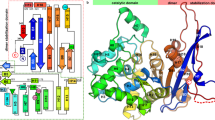Summary
Of five amidohydrolase activities subject to nitrogen metabolite repression in Aspergillus nidulans, l-asparaginase shows clearest evidence of also being subject to repression by atmospheric oxygen. Such oxygen repressibility is only evident under nitrogen metabolite derepressed conditions. Asparaginase levels are also considerably elevated by areA300, an altered function allele of the positive acting wide domain regulatory gene areA mediating nitrogen metabolite repression and are drastically reduced by loss of function mutations in areA. A. nidulans has two l-asparaginase enzymes and it has been shown by the use of appropriate mutants that these regulatory effects are exerted on the expression of that specified by the ahrA gene but probably not that specified by the apnA gene.
Similar content being viewed by others
References
Al Taho NM, Sealy-Lewis HM, Scazzocchio C (1984) Suppressible alleles in a wide domain regulatory gene in Aspergillus nidulans. Curr Genet 8:245–251
Arst HN, Jr (1982) A near terminal pericentric inversion leads to nitrogen metabolite derepression in Aspergillus nidulans. Mol Gen Genet 188:490–493
Arst HN, Jr, Bailey CR (1980) Genetic evidence for a second asparaginase in Aspergillus nidulans. J Gen Microbiol 121:243–247
Arst HN, Jr, Cove DJ (1973) Nitrogen metabolite repression in Aspergillus nidulans. Mol Gen Genet 126:111–141
Arst HN, Jr, Scazzocchio C (1975) Initiator constitutive mutation with an ‘up-promoter’ effect in Aspergillus nidulans. Nature 254:31–34
Arst HN, Jr, Scazzocchio C (1985) Formal genetics and molecular biology of the control of gene expression in Aspergillus nidulans. In: Bennett JW, Lasure LL (eds) Gene manipulations in fungi. Academic Press, New York, pp 309–343
Arst HN, Jr, Brownlee AG, Cousen SA (1982) Nitrogen metabolite repression in Aspergillus nidulans: A farewell to tamA? Curr Genet 6:245–257
Beauchamp C, Fridovich I (1971) Superoxide dismutase: Improved assays and an assay applicable to acrylamide gels. Anal Biochem 44:276–287
Caddick MX, Arst HN, Jr, Taylor LH, Johnson RI, Brownlee AG (1986) Cloning of the regulatory gene areA mediating nitrogen metabolite repression in Aspergillus nidulans. EMBO J 5:1087–1090
Carlioz A, Touati D (1986) Isolation of superoxide dismutase mutants in Escherichia coli: is superoxide dismutase necessary for aerobic life? EMBO J 5:623–630
Cohen BL (1972) Ammonium repression of extracellular protease in Aspergillus nidulans. J Gen Microbiol 71:293–299
Clutterbuck AJ (1974) Aspergillus nidulans. In: King RC (ed) Handbook of genetics, vol 1, Plenum Press, New York, pp 447–510
Clutterbuck AJ (1987) Aspergillus nidulans (nuclear genes). In: O'Brien SJ (ed) Genetic maps, vol 4. Cold Spring Harbor Laboratory, Cold Spring Harbor, New York, pp 325–335
Cove DJ (1966) The induction and repression of nitrate reductase in the fungus Aspergillus nidulans. Biochim Biophys Acta 113:51–56
Davis BJ (1964) Disc electrophoresis II: Method and application to human serum proteins. Ann NY Acad Sci 121:404–427
Drainas C, Kinghorn JR, Paterman JA (1977) Aspartic hydroxamate resistance and asparaginase regulation in the fungus Aspergillus nidulans. J Gen Microbiol 98:493–501
Engvall E (1980) Enzyme immunoassay ELISA and EMIT. Methods Enzymol 70A:419–439
Fridovich I (1978) The biology of oxygen radicals: The superoxide radical is an agent of oxygen toxicity; superoxide dismutases provide an important defense. Science 201:875–880
Fridovich I (1986) Biological effects of the superoxide radical. Arch Biochem Biophys 247:1–11
Gomori G (1955) Preparation of buffers for enzyme studies. Methods Enzymol 1:138–146
Hynes MJ (1975) Studies on the role of the areA gene in the regulation of nitrogen metabolism in Aspergillus nidulans. Aust J Biol Sci 28:301–313
Kapoor M, Lewis J (1987) Heat shock induces peroxidase activity in Neurospora crassa and confers tolerance toward oxidative stress. Biochem Biophys Res Commun 147:904–910
Lowry OH, Rosenbrough NJ, Farr AL, Randall RJ (1951) Protein measurement with Folin phenol reagent. J Biol Chem 193:265–275
McAdam ME, Fox RA, Lavelle F, Fielden EM (1977) A pulseradiolysis study of the manganese-containing superoxide dismutase from Bacillus stearothermophilus. Biochem J 165:81–87
McCord JM, Fridovich I (1968) The reduction of cytochrome c by milk xanthine oxidase. J Biol Chem 243:5753–5760
McCord JM, Fridovich I (1969) Superoxide dismutase: An enzymatic function for erythrocuprein (Hemocuprein). J Biol Chem 244:6049–6055
McCullough H (1967) The determination of ammonia in whole blood by a direct colorimetric method. Clin Chim Acta 17:297–304
McIlvaine TC (1921) A buffered solution for colorometric comparison. J Biol Chem 49:183–186
Pontecorvo G, Roper JA, Hemmon LM, Macdonald KD, Bufton AWJ (1953) The genetics of Aspergillus nidulans. Adv Genet 5:141–238
Rand KN, Arst HN, Jr (1977) A mutation in Aspergillus nidulans which affects the regulation of nitrite reductase and is tightly linked to its structural gene. Mol Gen Genet 155:67–75
Shaffer PM, Arst HN, Jr (1984) Regulation of pyrimidine salvage in Aspergillus nidulans: A role for the major regulatory gene areA mediating nitrogen metabolite repression. Mol Gen Genet 198:139–145
Shaffer PM, Estberg L, Fernando L, Sitter M (1986) Amidohydrolases regulated by areA300 in Aspergillus nidulans. Fed Proc 45:1546
Wiame J-M, Grenson M, Arst HN, Jr (1985) Nitrogen catabolite repression in yeasts and filamentous fungi. Adv Microbiol Physiol 26:1–88
Author information
Authors and Affiliations
Additional information
Communicated by W. Gajewski
Present address: (until 25 August, 1988) Department of Genetics, University of Georgia, Athens, GA 30602, USA
Rights and permissions
About this article
Cite this article
Shaffer, P.M., Arst, H.N., Estberg, L. et al. An asparaginase of Aspergillus nidulans is subject to oxygen repression in addition to nitrogen metabolite repression. Mol Gen Genet 212, 337–341 (1988). https://doi.org/10.1007/BF00334704
Received:
Issue Date:
DOI: https://doi.org/10.1007/BF00334704




